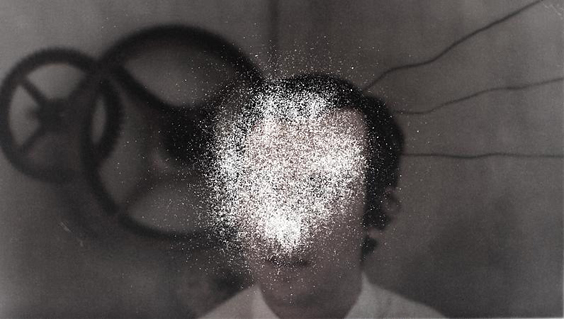
Hiraki Sawa, Lineament, 2012. Video still. Courtesy the artist and James Cohan Gallery, New York
In May of 2012, London based Japanese artist Hiraki Sawa was invited for the artist-in-residence at The Art Gallery of Ontario (AGO) in Toronto. During his stay, M-KOS attended his talk and met him at his studio at AGO. A few audio notes were recorded in the course of our visits, and from these the following texts were gathered, to encapsulate some of the highlight of this exchange, which trace his artistic journey from early work to the more recent “Lineament†(2012), currently on view at James Cohan Gallery in New York (through 27 April)
In conversation with Hiraki Sawa
 […] a box, far from being a dead end, is an entrance to another world. I don’t know to where, but an entrance to somewhere, some other world.
[…] a box, far from being a dead end, is an entrance to another world. I don’t know to where, but an entrance to somewhere, some other world.
― KÅbÅ Abe, “The Box Manâ€
“I only recently realized my work is all about displacement.†Sawa, best known for creating dreamlike animated world, came to notice the theme of “displacement†when rediscovering his very early works, a series of paintings of solitary airplanes, alone in the centre of miniature canvases against pitch-black backgrounds, produced whilst still in his foundation course in London, circa 1997.
Some years later, he shot the seminal “Dwelling†(2002) videos in his apartment. Herein, a number of beautifully choreographed miniature airplanes fly from room to room, landing and taking off from a dining table, a washing machine, a cooker and so on. All the tiny jets move in calm and tranquil air, weightlessly maneuvering.
“It’s not about flying but about looking at airplanes†Since his childhood, Sawa has been fascinated by airplanes, and went many times to Heathrow airport to go plane spotting. The airport’s viewing pod (now closed since 9/11) made it possible to take very close-up photos of the aircrafts, giving Sawa the Impression that he could almost touch them. “I like such sense of deception in distance and scaleâ€
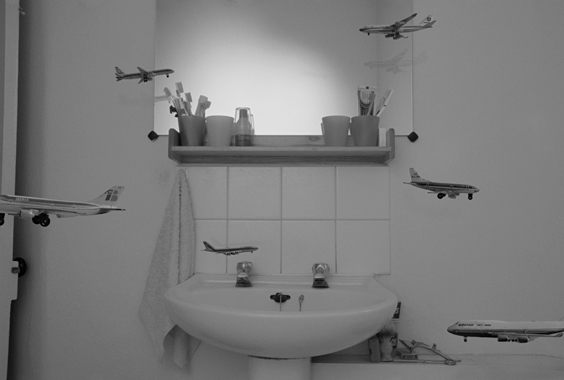
Hiraki Sawa, Dwelling, 2002. Video still. Courtesy the artist and James Cohan Gallery, New York
Sawa produced the Dwelling video for his final postgraduate show at the Slade School of Art. Just before this, he was making three dimensional work and large installations. But his appreciation for the potential of video grew quickly after working as a moving image assistant. “When I start working on a new project, I don’t usually have a very clear idea of how it will end up, only something very vague, just some kind of aura around my head. It’s only when I bring these into a certain form that I can figure out what I really want to express. I used to think I needed sculpture or three dimensional objects to achieve this but after working in video production, I realised that this was much more connected to my own sensibilities.â€
Since then, Sawa has been using video as his main expressive material. The transition was natural as he was previously interested in time-based and kinetic sculptures. “I want to be able to control time and movement. My work is always bound in time.â€
After Dwelling he produced more works that were shot from his apartment, such as Migration (2003), Elsewhere (2003), Spotters (2003) and Trail (2005). To change the settings of his films, he actually moved three times in the same timeframe, from one apartment to the next. The three channel video installation “Going Places Sitting Down†(2004) broke the above rule, as the latter was shot in an old English country house, in Bath. This move ambitious project featured a rocking horse moving across the deep waters of a bathtub, a fluffy soft carpet and other dreamlike scenes, along with a music box soundtrack.
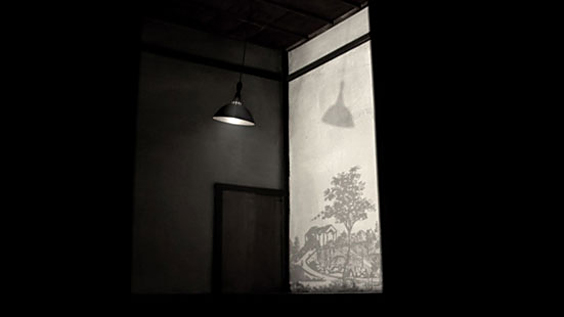
Hiraki Sawa, Talking to the Wall, from Hako, 2007. video still. Courtesy the artist, CHisenhale Gallery, London and Ota Fine Arts, Tokyo
Sawa’s game changing exhibition occurred in 2007 with his “Hako†video, commissioned by London’s Chisenhale Gallery. He produced a multi-channel video installation consisting of six large video projections, each resonating poetically with one another. Every screen was individually titled: “For A Momentâ€, “Mossâ€, “Fragmentsâ€, “Kaeri Michiâ€, “Talking to the Wall†and “The Birds and the Seaâ€. In an otherwise dark and silent space, the viewer easily lost sense of place and was drawn to a state of reverie. “For Hako, I loosened my emphasis on technical control and I decided to solely follow my instinct. I made decisions as if throwing a dice, almost unconsciously. My only constraint was to keep a certain tempo, like the toy clock counting real-time in Fragmentsâ€
Hako is literally taken from ‘Hakoniwa Ryoho’, the Japanese translation of ‘Sandplay therapy’, developed by Swiss psychotherapist Dora M. Kalff, where patients are asked, according to their inner state, to arrange a number of toys in a child’s sandbox. Sawa here experimented with a similar form of therapy in using video instead of sand, with the gallery space acting as a containing box.
In 2009, Sawa created the single channel projection “Siltsâ€, in juxtaposition with an array of actual still objects, safe for the inclusion of a clock, moving its hands to keep time. Movement and stillness are here finely confounded in only allowing the time piece to connect the gap. Whilst Sawa’s work is often described as calming and promoting a dream-like state, this piece marks a departure from such stereotypes. “Silts is a work which made people cry, it made them feel disgusted, somehow. So it was actually not so popular as a piece [laugh] but for what I intended to do it was successful. It sounds terrible but I wanted to find out for myself: ‘can I provoke emotion onto people through my work? I wanted to find out about this emotional potential.â€
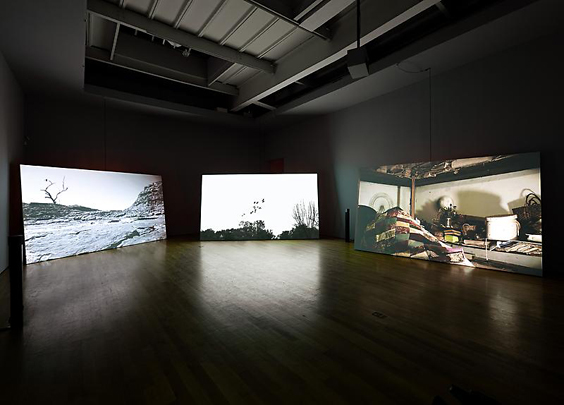
Hiraki Sawa, O, 2009. Installation view. Courtesy the artist and James Cohan Gallery in New York
In the same year, Sawa created “O†for the 6th edition of the Asian Pacific Contemporary Art Triennial, commissioned by Queensland Art Gallery. This again comprised multiple channels, from a large-scale triptych of projections, to ten small video monitors and five channels of audio. Australian landscapes unfold onscreen with flowing water and seemingly endless desert, populated by birds flying in slow motion, or as the artist put it: “in active stillnessâ€. Shot both in monochrome and colour, the videos juxtapose these vast expanses with interior views of an old house in the South of France, on the three large, slightly tilted panels. By contrast, the wall embedded monitors feature a church bell, light bulb, tea cup and other domestic objects endlessly spinning to suggest a cyclic looping of time. “It was very important that these spinning objects rotate endlessly. Because the other images on the larger panels had a more linear sequence. By suggesting a cycling motion, I wanted to bring the passing of time back to its beginning, through movement.â€
 Coming full circle is movement without displacement. In that time, you simply are, and all change is in the looking.
Coming full circle is movement without displacement. In that time, you simply are, and all change is in the looking.
– Hiraki Sawa
In “Oâ€, there are many recurring objects coming from his signature inventory of airplane, the moon, rocking horses, Ferris wheels, clocks, birds, goldfish and so on. “I haven’t changed that much really [chuckle].â€
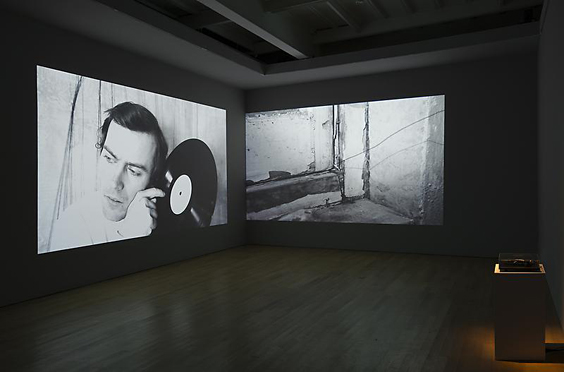
Hiraki Sawa, Lineament, 2012. Installation view. Courtesy the artist and James Cohan Gallery in New York
Originally shown at Shiseido Gallery in Tokyo in 2012 and currently on view at James Cohan Gallery in New York, Sawa’s recent work “Lineament†(2012) was inspired by the experience of a close friend succumbing to amnesia: losing all knowledge of his own identity, his past; he even lost the sense-perception of his tastebuds. The two-channel video installation is accompanied by a soundtrack played on a vintage turntable, to highlight Sawa’s record collecting interest, once shared with his amnesiac friend. Filmed on a custom set in his London studio, Sawa used stop motion techniques to evoke early dada or surrealist animations, and for the first time, he hired an amateur actor to play the film’s main protagonist.
Lineament is the second installment of the “Figment†series from which the current exhibition takes its name, initiated with “did i?†from his 2011 show at James Cohan Gallery in New York. Whilst the latter considered the erasure of memory, Lineament dealt instead with recalling memory. Here the vinyl records appear as the key metaphor for the act of recollection in the film. “When I realised that the line on a record is actually spiral, I decided to use it as a metaphor for memory, a line of event. If you listen to a compilation album for example, the first track could be R&B, the second reggae, the third pop and so on. But it is all contained in one line. Our memory is just like that.â€
Although Sawa’s stop motion film is painstakingly meticulous to produce, the resulting work seems totally effortless. For instance, instead of using computer technology, he personally cut the etching on the vinyl code to make it into one continuous line drawing, and seemingly demonstrated a masterwork of craftsmanship in sculpting in time, to paraphrase Russian film director Andrei Tarkovsky. “I always try to make a work with a visual image so powerful that the viewer can be drawn deeply into it and not need any verbal explanation. If you have to explain your work, for me it is not powerful enough.†â–
Hiraki Sawa “Figment†is on view at James Cohan Gallery until 27 April 2013.
James Cohan Gallery
533 West 26th Street
New York NY 10001
USA
jamescohan.com
Opening hours
Tuesday – Saturday: 10h00 – 18h00
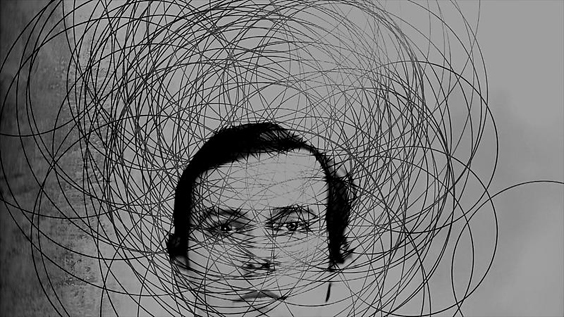
Hiraki Sawa, Lineament, 2012. Video still. Courtesy the artist and James Cohan Gallery, New York
